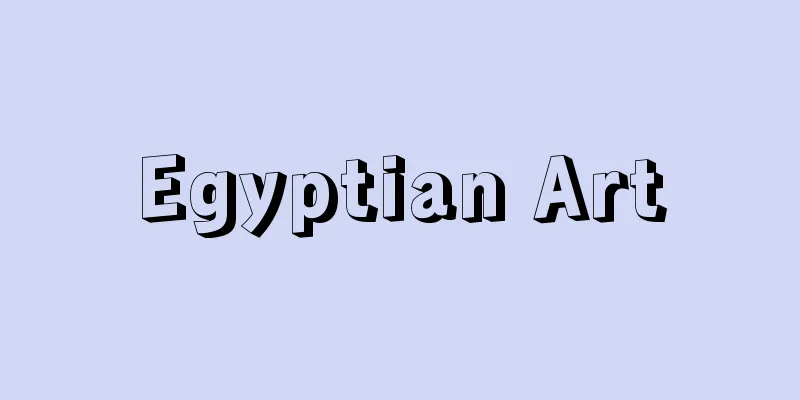Egyptian Art

|
The ancient Egyptian kingdom was established on the integration of two contrasting lands along the Nile River: Upper (South) Egypt and Lower (North) Egypt. The sole and absolute king who ruled over them was called "King of Upper Egypt" and "King of Lower Egypt", and each region was represented by papyrus and water lilies. This dualistic idea had a strong influence on the basic character of plastic arts. They also recognized gods in the heavens and the workings of nature, believed in the existence of countless souls, and the Pharaoh (king), the son of God, was the intermediary between gods and humans. They believed in eternal life and resurrection of the dead, and buried the dead with great care, but this concept did not change essentially except for a period of religious reform by King Akhenaten. Therefore, only slight changes can be seen in art styles over a long period of several thousand years. Before the 1st Dynasty, the people settled along the Nile and began farming in the Predynastic Period, when painted pottery was discovered at ruins such as Deir Tasa, El Badari, and Gherzeh. The 1st to 31st Dynasties (c. 3000 BC to 332 BC) produced magnificent tombs, temples, sculptures, paintings, and crafts. [Nao Tomobe] Architecture: Tombs and templesEgyptians believed in the resurrection of the dead, and built sturdy tombs as eternal homes for the dead. During the establishment of the dynasty, tombs for kings and nobles called mastabas (meaning seat in Arabic) were built. Sun-dried bricks were piled up in a platform shape on a rectangular foundation, a vertical hole was dug underground, and a burial chamber and an auxiliary room were built next to it to place the body, with the image of the deceased carved in relief on the walls. Many mastabas were later built as tombs for the king's close associates. Magnificent pyramids were built one after another during the Old Kingdom period from the 1st to 6th dynasties (c. 3000 BC to c. 2263 BC). Imhotep, the architect and vizier of the 3rd dynasty King Djoser, built a six-tiered stepped pyramid for the king using stone and mortar. In the 4th dynasty following King Djoser, a so-called regular square pyramid-shaped tomb was completed. On the Gizeh plateau near Cairo, from north to south, are the pyramids of Khufu, Khafra, and Menkaure. The largest, that of King Khufu, is 146 meters high and is estimated to have been made up of 2.3 million stones averaging 2.5 meters each. Each ridge runs east, west, north, and south, and the king's chamber is located almost in the center of the stone mass. The pyramids were built with worship places, approach ways, and river valley temples on the banks of the Nile, and mastaba tombs for royalty and nobility were built around the pyramids. During the 5th Dynasty, worship of the sun god Ra became stronger, and obelisks were erected as symbols of the rising sun. These huge stone buildings were made possible by the abundant stone produced in various parts of Egypt. During the 11th and 12th dynasties (c. 2160-1785 BC), or Middle Kingdom period, when North and South Egypt were unified by Theban rulers, pyramids became significantly smaller in size and few remain because they were built with sun-dried bricks. The mortuary temple of King Mentuhotep of the 11th dynasty at Deir el-Bahari in Thebes features a small pyramid on a double base, marking a return to the ancient ideal. During this period, the tombs of nobles and high-ranking officials were not built near the king's pyramid, but were buried near their hometowns. In the north, the mastaba style was followed, while in the south, rock-cut tombs, which were carved into the middle of the tomb, were actively built. Examples can be seen in the magnificent rock-cut tombs of Beni Hassan and Aswan. After the 12th Dynasty, the dynasty declined, and the 18th Dynasty began as a unified dynasty around 1580 BC. From this period until the 20th Dynasty, around 500 years later, pyramids were no longer built as royal tombs. Pyramids that were clearly royal tombs at first glance were targeted by tomb robbers looking for the luxurious grave goods, and were plundered to the last. From the 18th Dynasty of Thutmose I onwards, the mummies of the kings were buried in the Valley of the Kings on the west bank of the Nile, with the entrance hidden, and a funeral temple was built in a distant location. The royal tombs were designed with a long corridor extending from the entrance, with a deep pit on the way, followed by a room with a square pillar, an antechamber, and an antechamber. The antechamber contained a sarcophagus containing the mummy, and a separate canopic container containing the viscera and a small chamber for the grave goods. Despite the entrance being carefully concealed, all the royal tombs in the Valley of the Kings were uncovered, and only Tutankhamun's tomb escaped looting, and was discovered by Howard Carter in 1922. The kings' mummies were moved to a safe place by the priests, and were able to rest in peace until their discovery at the end of the 19th century. Funerary temples, intended for the purpose of worshiping gods and offering offerings to dead pharaohs, were built far away from the Valley of the Kings, on the foot of the desert plateau or on flat land facing the Nile. They have a pylon, a courtyard, a portico, a hypostyle hall, an inner sanctuary, and storehouses, and follow the typical form of a New Kingdom temple. An example of this type of funerary temple is the mortuary temple of Ramses III at Madinat Habu. A unique funerary temple is the mortuary temple of Queen Hatshepsut at Deir el-Bahari in the 18th Dynasty. It consists of three terraces connected by ramps, with the lower terrace being a forecourt, a colonnade in front of the courtyard terrace, and the god Amun enshrined at the back of the upper terrace. Almost no temples remain from the Middle Kingdom, and most of the extant ruins are from the New Kingdom and the end of the period. A typical temple plan is seen in the Temple of Khonsu at Karnak in Thebes. There is a pylon with an obelisk at the front, and a courtyard with colonnades on both sides leads to an entrance. Beyond the entrance is another hypostyle hall, and behind it only the priests and the king are allowed to enter. There is a room for the sacred boat that carries the statue of the moon god Khonsu on certain holidays, and next to the back wall is the sanctuary where the statue is enshrined, and three other rooms are lined up. The Great Temple of Amon, which is the center of the Karnak temple complex, and the Temple at Luxor are large and complex, but their fundamental elements are the same as those of the Temple of Khonsu. At Luxor, the pillars of unflowered and flowering papyrus erected by Amenhotep III are noteworthy. The huge 16-meter-high column, together with the detailed bas-reliefs of the Opet Festival that King Tutankhamun had carved on the side walls of the colonnade, are the highlight of the temple. The colonnade, which is one of the characteristics of Egyptian architecture, is made up of both square and round columns. Some of the square columns have the head of the goddess Hathor carved into the capital in relief, and some have the image of the king in shroud. The round columns are proto-Doric columns with eight or sixteen faces, and some have motifs of various plants. Ramses II of the 19th Dynasty placed two obelisks and six colossi in front of the second pylon of Luxor. One of the obelisks was presented to France and is now in the Place de la Concorde in Paris. The temple style of the New Kingdom was also adopted in the temples of the later period at Dendera, Edfu, Philae, and other places. In areas where the desert plateau comes close to the banks of the Nile, rock-cut temples were built by carving part or all of the temple into the cliffs. An example of this is the temple of Abu Simbel, which was cut and moved to make way for the Aswan High Dam, and was built by Ramses II. Ramses II also built or expanded temples in Memphis, Abydos, Karnak, Luxor, and other places, sometimes even erasing the inscriptions of other kings to have his own name engraved on them. He was the king of ancient Egypt who left behind the most structures, but he also left behind the dishonorable name of a falsifier of inscriptions. In contrast to the tombs and temples, which were built sturdily using stone, ordinary residences were built using less durable materials such as sun-dried bricks and wood, and even royal palaces were no exception. Although few remain today, there are remains of the palace built by the 18th Dynasty pharaoh Amenhotep III at Malkata, west of Thebes, and of a housing complex for craftsmen. [Nao Tomobe] Round carvingThese include statues of gods, statues of kings and nobles placed in temples and tombs, and small human figures as grave goods. The materials used were stone, metal, wood, ivory, pottery, etc. The stones ranged from hard ones such as diorite, granite, and breccia to soft ones such as limestone, sandstone, and alabaster. The metals were mainly copper and bronze, and the woods used were mainly Egyptian ones such as acacia and fig, as well as imported coniferous trees. Ancient Egyptian sculptures were not works of art in the modern sense, but were intended for funerals and worship, and with the development of tombs, gigantic statues began to be placed in places of worship. This type of statue, which began in the Old Kingdom, is characterized by realistic depictions, particularly of facial features, so that the spirit of the deceased can easily reside in it. In the Old Kingdom, the throne statue of Djoser (3rd Dynasty, Cairo Museum) bearing the inscription of its sculptor Imhotep was the first life-size tomb statue, and the statue of Rahotep and Nefert (4th Dynasty, Cairo) retains vivid colors, and the crystal eyes enhance the realism of the statue. The throne statue of Khafra (4th Dynasty, Cairo) is a masterpiece that expresses the dignity of a king, and the standing statue of King Menkaure (4th Dynasty, Boston Museum of Fine Arts) is a typical example of a dignified couple statue. A distinctive feature of Egyptian sculpture is that in upright figures, the face is facing forward, and either both feet are together or one foot (usually the left foot) is half a step forward. The same is true for seated figures, and in some statues of couples, the wife has her arms around her husband's back. Egyptian sculptures generally have little movement, but those that do have movement often express the person's occupation or status, such as the wooden village chief statue from the 5th Dynasty (Cairo) and the cross-legged scribe statue (Louvre Museum). During the Middle Kingdom, two schools of sculpture emerged: the Memphite school in the north and the Theban school in the south. The Northern School continued the traditions of the Old Kingdom, producing refined but typical sculptures such as the seated statue of Amenemhat III excavated at Hawara (Cairo). The Southern School, in addition to its rough and powerful style, also adopted the realistic techniques of the Memphite School to portray the characters of the figures. The early New Kingdom is graceful but lifeless, with only a few statues, such as the standing statue of Tutmosis III (Cairo) and the seated statues of Amenhotep III and his wife Tiye, which are colossi worthy of a grand temple. In the latter part of the New Kingdom, Amenhotep IV implemented religious reforms by adopting the belief in the sun god Aten, but after he renamed himself Akhenaten and moved the capital to present-day Amarna, the so-called Amarna art emerged, producing refined and beautiful works such as the bust of Queen Nefertiti (Berlin State Museum). Akhenaten's religious reform ended when the next king, Tutankhamun, moved the capital to Thebes, but artistic activity in the Amarna period continued for some time. The 19th Dynasty had some elaborate works such as the seated statue of Ramses II (Turin Museum of Ancient Art), but the huge self-portraits that the kings dedicated to temples around the country were crude and few of artistic merit. After the 20th Dynasty, there were no stone statues worth seeing, but bronze sculpture made a remarkable development. The standing statue of Queen Karomama (Louvre) of the 22nd Dynasty is an elegant work with gold inlay in the details of her clothing. Other examples include the statue of Mentuemhat (around the 25th Dynasty, Cairo) and the head of a priest (around the 30th Dynasty, Berlin), which depict the human's facial expression with great detail. With the advancement of casting technology, many small statues of divine beasts were created in the Late Dynastic Period, such as the hawk of the god Horus and the cat of the goddess Bastet. From the Ptolemaic dynasty to the Roman period, the sculptures that Egyptians used to express religious ideals became mere formalities, and Greco-Roman style works began to be created. [Nao Tomobe] Reliefs and paintingsAmong the reliefs, there are palettes made for offerings to temples from before the Old Kingdom. The palette of King Narmer (1st Dynasty) is important, depicting the historical event of the unification of Upper and Lower Egypt. The burial chambers of the pyramids are decorated with reliefs, and the Pyramid Texts of King Unas (5th Dynasty, Saqqara) are noteworthy. During the 5th Dynasty, tombs for nobles developed, and the walls of the worship halls were decorated with reliefs depicting the dead living happily in the afterlife. Boating, farmers, boatmen, and craftsmen at work are carved in detail. Temples and funerary temples depict the king's biography and the king worshiping the gods and receiving blessings. During the Greco-Roman period, the reliefs became rounder and the contours softer, but the anatomical accuracy of the human body was lost. Paintings, like the reliefs, were polychrome, using the following main pigments: red from ochre, yellow from porcelain, blue from malachite or blue frit (a raw material for glass), green from peacock stone or green frit, black from ink, and white from chalk or gypsum, with glue, resin, and egg white used as binders. A drawing of a duck excavated from Meidomu (4th Dynasty, Cairo) from the Old Kingdom shows an accurate depiction of its feathers. During the Middle Kingdom, murals began to be applied to the tombs of nobles, but they are not in good condition. By the New Kingdom, murals were well preserved, and those painted in the tombs of Theban kings and nobles vividly recall the patterns of the time. Themes of the murals include funeral processions, the opening ceremony to admit the soul into the mummy, and the dead being welcomed by the gods of the underworld. These guidebooks to the underworld are important in the study of religious documents, and the papyrus scrolls include the Book of the Dead, which is a collection of instructions for helping the dead journey to the afterlife. During the Amarna period, paintings included scenes of royal families enjoying family time together, as well as birds and animals in nature, which are linked to the worship of Aton. The tombs of artisans and minor officials at Deir el-Medina also depict the dead receiving memorial services. From scenes depicting hunting, fishing, and funerals in which the deceased eats with family and relatives, we can get a glimpse into the daily lives of ordinary people at the time. In depicting these figures, the expression of the human body that is appropriate for eternity was pursued with great enthusiasm. Egyptian painting developed independently, independent of the perspective and see-through methods that are the basis of Western realistic depictions. Reliefs and paintings also share the same conventions of expression. To express a three-dimensional world as flat art, the face is drawn in profile, and one eyebrow and eye are drawn as if seen from the front. Both shoulders are drawn from the front, the chest and torso from the side, the buttocks from the diagonal back, and the feet as if seen from the side. This is called the law of frontality or variable perspective drawing, and is a conceptual drawing method rather than drawing what is actually seen, and this method was already established at the beginning of the Third Dynasty. The proportions of the figures are also strictly determined based on the length of the fist, such as 18 from the hairline to the sole of the foot, and 2 from the forehead to the shoulder, which shows the nature of so-called primitive art. Paintings were not only found on the walls of tombs, but also on wooden coffins, papyrus, and ostraca (pottery fragments). Wooden coffins became common toward the end of the Old Kingdom, and they had false doors and human eyes painted in thick ink on the top. This was so that the deceased could see the outside world through these eyes while lying down. Ostraka are pieces of limestone or pottery used as notebooks or books of accounts, and they depict freely depicted religious scenes as well as secular scenes from everyday life. [Nao Tomobe] CraftsBlessed with abundant materials and talent, the Egyptians also achieved brilliant results in the field of crafts, including stone tools, pottery, metalwork, woodwork, tusk and horn products, and textile products. The walls of the huge temples and tomb chambers are decorated with countless murals and reliefs depicting a variety of occupations and customs, giving us an insight into the actual state of craft production at the time. The motifs featured in the crafts include plants such as water lilies, papyrus, and palms, natural objects such as hawks, cobras, beetles, goats, and humans, symbolic Egyptian figures such as the ankh (life), Eve (heart), and Werezu (rebirth), and simple geometric patterns such as rosettes, zigzags, and spirals. These are intricately combined and endowed with religious meanings, and have symbolism other than aesthetic beauty. Among stone tools, the flint knives from the late Predynastic period are particularly beautiful, and while harder stones were used for stone containers during the Predynastic period, alabaster, which is translucent and easy to carve, was widely used for jars and other items during the Dynastic period. Palettes appeared around the time of the 1st Dynasty. These were originally stone slabs for grinding up makeup pigments, but were later carved all over and used as votive offerings to temples. Pottery in the strict sense of the word did not develop in Egypt, but during the Dynastic Period, a type of pottery was produced by solidifying quartz powder with soda or salt water to create a base, then applying a glaze to it. This type of glaze was mainly a bright, eye-catching blue, and during the Middle Kingdom, small animal figurines covered in this blue glaze, bowls with water lily flowers painted in black over the blue glaze, and amulets were created as grave goods. During the New Kingdom, many high-rises and small statues (ushabchi) covered in this type of blue glaze were produced, as were tiles and other building materials. In addition to blue, glazes came in green, white, yellow, and other colors. Glass is a glaze that has been worked on by itself. There is a footed cup named after King Tutmose III from the 18th Dynasty, and the remains of glass factories have been found at Thebes and Tell al-Amarna. The magnificent purple and yellow striped fish vase in the British Museum reflects the naturalism of the Amarna period. All glass at that time was colored and opaque, and was considered a substitute for gems and precious stones. The techniques of glassblowing and slow cooling were not yet known, so rags were wrapped around the end of metal rods, and molten glass was wrapped around them, and the inside was scraped out after cooling. In this way, decorative plates, vases, bottles, cups, etc. were made. The earliest base metal discovered and used in Egypt was copper, which was around since the Badari period, while bronze, which originated in Western Asia, became widespread during the Middle Kingdom. Techniques for processing copper and bronze include forging, casting, soldering, and plating with gold and silver. Among precious metals, gold was known from early times. There are many gold mines from the eastern bank of the Nile to the Red Sea, and its everlasting lustre led to its use in a variety of decorative items. It was used to frame the rims of pots and to wrap the handles of stone knives. A flint knife at the Cairo Museum has a thin gold plate wrapping the handle, with animal and plant patterns intricately engraved on it, demonstrating the delicate sensibility and engraving techniques of the people at that time. Queen Zeru's bracelet from the 1st Dynasty is an attractive piece that skillfully utilizes casting and engraving techniques using lapis lazuli, turquoise, amethyst, and other elements. An example of a craft that uses a large amount of gold is the golden coffin of King Tutankhamun (18th Dynasty). The wooden works include models of boats. For the Nile people, boats were a subject closely related to their daily lives, and there were a variety of boats, from small fishing boats to large, luxurious ships with cabins and sails. However, the main wooden work was still furniture, with the legs of beds, chairs, stools and other items carved into the shapes of animal legs, and even individual legs were decorated with beautiful sculptures. The structure of the furniture itself was rational, and the beds were made of wood, with a sturdy wooden frame stretched with a net made of vegetable fiber, on which people slept on top of linen that had been folded several times. Apart from furniture, wooden works also included adorable small crafts such as spoons, mirror cases, and small boxes. [Nao Tomobe] "World Art Collection 21: Orient 2: Egypt" edited by Norio Shinra (1965, Kadokawa Shoten)" ▽ "World Art Collection 3: Egyptian Art" edited by Isamu Sugi (1972, Gakken)" ▽ "Orient and Aegean Art" by W. Wols, translated by Naoyuki Tomobe (1979, Graphic-sha)" [References] |Mastaba of the tomb of the court official Perneb (relocated and reconstructed). Old Kingdom period (around 2381-2323 BC). Limestone. Height 482.2 cm. Memphis, Egypt . Collection of the Metropolitan Museum of Art . Mastaba Underground part of the tomb of the court official Perneb (relocated and reconstructed). Old Kingdom period (around 2381-2323 BC). Limestone, painted. Height 482.2 cm. Saqqara, Memphis, Egypt . Collection of the Metropolitan Museum of Art . Mastaba (altar room) The pyramids of Khufu are in the back left, Khafra in the center, and Menkaura in the front right. Part of the World Heritage Site "Memphis and its Necropolis: The Pyramid Fields from Gizeh to Dahshur" (Egypt, registered in 1979) Egypt Gizeh (Giza) ©Shogakukan "> The three great pyramids of Gizeh A temple dedicated to Amun, the supreme national god. It was designed by Senmut, a favorite of Queen Hatshepsut, during the 18th Dynasty. The three terraces are connected by a ramp. Part of the World Heritage Site "Ancient Thebes and its Necropolis" (Egypt, registered in 1979) Luxor, Egypt ©Shogakukan "> Temple of Hatshepsut The photo shows an unflowered papyrus column, 16 meters tall. Part of the World Heritage Site "Ancient Thebes and its Necropolis" (Egypt, registered in 1979) Luxor, Egypt ©Shogakukan "> Columns of the Luxor Temple The Great Temple. 33m high, 38m wide. The four statues of Ramses II are 20m high. Part of the World Heritage Site "Nubian Monuments from Abu Simbel to Philae" (Egypt, registered in 1979) Egypt Abu Simbel ©Shogakukan "> Abu Simbel Temple Ancient Egyptian architecture 2061-1998 BC 11th Dynasty Deir el-Bahri (Egypt) Pillar-beam structure and pyramid combination ©Shogakukan "> Diagram of the mortuary temple of Mentuhotep II Late Period (664 BC - 332 BC or earlier) Bronze and other materials Height: 17.6 cm Collection of the Metropolitan Museum of Art Horus A diagram of the trial of the dead. The heart (soul) of the deceased is placed on the left side of the scales, and the feather of Maat, the goddess of justice and truth, is placed on the right side to measure the weight of the sins. Osiris, the king of the underworld, is depicted on the far right, and Anubis in the center. Third Intermediate Period (around 1050 BC) Papyrus, colored. Deir el-Bahari Metropolitan Museum of Art, Thebes, Egypt . "Book of the Dead" Discovered near the entrance to Tutankhamun's tomb. New Kingdom (1186-1070 BC), limestone, 14cm high, Egypt, Thebes, Valley of the Kings, Metropolitan Museum of Art . Hunting scenes depicted on ostraca A hippopotamus statue with water lilies painted on its surface. Middle Kingdom (c. 1961-1878 BC) Faience Height 11.2 cm Collection of the Metropolitan Museum of Art "> Animal statues New Kingdom (1550-1458 BC) Faience Diameter 28cm Egypt Collection of the Metropolitan Museum of Thebes A pot with a water lily design Middle Kingdom (c. 1981-1975 BC) Wood, painted 175 x 30.5 x 37 cm Collection of the Metropolitan Museum of Art Model of an ancient Egyptian boat The legs are carved in the shape of animal legs. New Kingdom (1492-1473 BC) Wood Height 53cm Egypt Collection of the Metropolitan Museum of Thebes Ancient Egyptian Chair Source: Shogakukan Encyclopedia Nipponica About Encyclopedia Nipponica Information | Legend |
|
古代エジプト王国はナイル川に沿って上(南)エジプトと下(北)エジプトという対照的な二つの土地の統合のうえに成り立っていた。これを支配する唯一絶対の王は「上エジプトの王、下エジプトの王」と称し、パピルスとスイレンでそれぞれの地域を表した。こうした二元的観念は造形芸術の基本的性格に強い影響を与えた。また天体や自然の営みのなかに神を認め、無数の霊魂の存在を信じ、神と人間との交流の媒介者が神の子ファラオ(王)であった。彼らは永遠の生命と死者の復活を信じて死者を手厚く葬ったが、この概念は、イクナートン王の宗教改革の一時期を除いて、本質的な変化はなかった。したがって美術様式も数千年にわたる長い期間に微々たる変化しか認められない。 第1王朝以前、ナイル河畔に定着して農耕を行うようになった先王朝時代では、デル・タサ、エル・バダリ、ゲルゼーなどの遺跡から彩色土器が発見されている。第1王朝から第31王朝まで(前3000ころ~前332)の王朝時代には、壮大な墳墓や神殿、彫刻、絵画、工芸を生んだ。 [友部 直] 建築――墳墓と神殿エジプト人は死者の復活を信じ、死者のための永遠の家として、頑丈な墓を築いた。王朝成立期、マスタバ(アラビア語で腰掛の意)とよばれる王や貴族の墓がつくられた。長方形の基盤の上に日干しれんがを台状に積み重ね、地下に竪穴(たてあな)を掘り、それに接して遺体を安置する玄室と付属室をつくり、壁には死者の姿を浮彫りで刻んだ。マスタバは、のちに王の側近の墓として多くつくられた。 第1王朝から第6王朝まで(前3000ころ~前2263ころ)の古王国時代には壮大なピラミッドが次々と建設された。第3王朝のジョセル王の宰相で建築家のイムホテプは、石材とモルタルを使って、王のために6段の階段式ピラミッドを築いた。ジョセル王に続く第4王朝には、正四角錐(すい)のいわゆるピラミッド型の墳墓が完成した。カイロ近郊のギゼーの台地には、北からクフ、カフラ、メンカウラの各王のピラミッドがある。最大のクフ王のものは、高さが146メートル、平均2.5メートルの石が230万個積み上げられたと推定され、各稜線(りょうせん)は東西南北をさし、王の玄室は石積みの塊体のほぼ中央にある。ピラミッドには礼拝所、参道、ナイル川岸の河谷神殿が付属してつくられ、ピラミッド周辺には王族や貴族のマスタバ墓がつくられた。第5王朝には太陽神ラーの信仰が強まり、日の出の象徴としてオベリスクが建てられた。これらの巨大な石造建築を可能にしたのは、エジプト各地から豊富に産出する石材であった。 テーベの統治者によって南北エジプトが統一された第11王朝と第12王朝(前2160ころ~前1785ころ)、すなわち中王国時代になると、ピラミッドの規模は著しく小さくなり、日干しれんがでつくられたために残存するものは少ない。テーベのデル・エル・バハリにある第11王朝のメントゥホテプ王の葬祭殿は、二重の基壇の上に小型のピラミッドをのせ、古代理想への復帰を示している。この時代、貴族や高官の墓は王のピラミッド周辺にはつくられず、出身地の近くに埋葬された。北部ではマスタバ形式を踏襲し、南部では墓の中腹に横穴式に掘る岩窟(がんくつ)墓が盛んにつくられた。ベニ・ハッサンの華麗な岩窟墓やアスワンにその例をみることができる。 第12王朝以後王朝は衰微し、紀元前1580年ころに統一王朝として第18王朝が始まる。これより第20王朝までの約500年間に及ぶ新王国時代ころになると、王の墳墓としてのピラミッドはもう築かれなくなる。一見して王の墓とわかるピラミッドは、豪華な副葬品目当ての墓泥棒にねらわれ、余すところなく略奪された。第18王朝のトゥトメス1世からは、王のミイラはナイル西岸の「王家の谷」に入口を隠して埋葬され、はるか離れた場所に葬祭殿が建てられた。 王墓の形式は、入口から長い通廊が延び、途中深い落し穴があり、角柱のある部屋、前室、玄室と続く。玄室にはミイラを納めた石棺が置かれ、別に内臓を納めたカノープス(カノピス)容器や副葬品のための小室があった。入口は慎重に秘匿されたにもかかわらず、王家の谷の王墓はすべて暴かれ、ツタンカーメンの王墓だけが略奪を免れて、1922年ハワード・カーターによって発見された。王たちのミイラだけは神官たちの手によって安全な場所に移され、19世紀末に発見されるまで安息の眠りにつくことができた。 神への祭祀(さいし)と死せるファラオへの供養を目的とした葬祭殿は、王家の谷からはるか離れて、ナイル川に面した砂漠の台地の裾(すそ)や平地に建てられた。葬祭殿は塔門、中庭、柱廊玄関、列柱室、内陣、倉庫を備え、典型的な新王国神殿の形式を踏んでいる。この形式のものとしてマディーナト・ハブのラムセス3世の葬祭殿がある。特異な葬祭殿として第18王朝のハトシェプスト女王のデル・エル・バハリの葬祭殿があげられる。傾斜路で結ばれた3段のテラスからなり、下段テラスは前庭で、中庭テラスの前面に柱廊を配し、上段テラスの奥にアモン神を祀(まつ)る。 神殿は中王国時代のものはほとんど残らず、現存する遺跡は新王国時代および末期のものが大部分である。典型的な神殿プランはテーベのカルナックのコンス神殿にみられる。前面にオベリスクを立てた塔門(ピュロン)があり、中庭を入ると左右に列柱があり玄関となる。玄関の先はふたたび列柱室となり、その奥は神官と王しか入ることを許されない。特定の祝祭日に月の神コンスの神像を乗せて運ぶ聖舟を安置する部屋があり、奥壁に接して神像を祀る至聖所と三つの部屋が並んでいる。カルナック神殿群の中心をなすアモン大神殿や、ルクソール神殿は、規模も大きく複雑だが、根本の要素はコンス神殿と同じである。ルクソール神殿で注目されるのは、アメンヘテプ3世が立てた未開花のパピルスと開花のパピルスの柱である。高さ16メートルの巨大な円柱列は、柱廊の側壁にツタンカーメン王が刻ませたオペト祭の精密な薄浮彫りとともに、神殿中の白眉(はくび)となっている。エジプト建築の一つの特徴ともいえる列柱には角柱と円柱がある。方形の柱には、女神ハトホルの頭部を浮彫りで柱頭部につけたものや、屍衣(しい)をまとった王の像の柱があり、円柱には8、16などの面をとったプロト・ドリス柱、各種の植物をモチーフにしたものがある。第19王朝のラムセス2世はルクソールの第2塔門前に2本のオベリスクと6体の巨像を置いた。オベリスクのうちの1本はフランスに贈呈され、現在パリのコンコルド広場にある。このほか、新王国の神殿様式はデンデラ、エドフ、フィラエなどの末期の神殿にも踏襲された。 砂漠の台地でナイルの川岸まで迫っている地方では、神殿の一部あるいは全部を崖(がけ)の中に掘り込む岩窟神殿がつくられた。アスワン・ハイ・ダムのために切断移転したアブ・シンベル神殿がこの例で、ラムセス2世の建造による。ラムセス2世はメンフィス、アビドス、カルナック、ルクソールなどにも神殿を新築または増築し、ときには他の王の銘を削ってまで自分の名を刻ませた。古代エジプト諸王のうちもっとも多くの建造物を残した人物であり、銘の改竄(かいざん)者としての不名誉な名も残した。 墳墓や神殿が石材を用いて頑丈に築かれたのに反して、一般の住居は日干しれんがや木材など耐久力の乏しい材料でつくられ、王宮といえども例外ではなかった。現存するものは少ないが、第18王朝のアメンヘテプ3世がテーベの西マルカタに造営した宮殿や、職人の集合住宅の跡が残っている。 [友部 直] 丸彫り彫刻これには神像をはじめ、神殿、墳墓に安置した王や貴族の像、副葬品の小形人物像などがある。その材料は石、金属、木、象牙(ぞうげ)、陶器などで、石には閃緑(せんりょく)岩、花崗(かこう)岩、角礫(かくれき)石などの硬質のもの、石灰岩、砂岩、アラバスターなどの軟質のものがあり、金属は主として銅および青銅、木材はアカシア、イチジクなどのエジプト産のもののほか、針葉樹の輸入材が多く用いられた。 古代エジプトの彫刻は、現代的な意味での芸術作品というより、葬礼や崇拝のためのもので、墳墓形式の発達とともに巨大な人物像が礼拝所に安置されるようになる。古王国時代から始まったこの種の像では、死者の霊が宿りやすいように、とくに容貌(ようぼう)を正確に写そうと努める写実的な表現が特色である。古王国時代では、制作者イムホテプ銘のあるジョセル王座像(第3王朝、カイロ美術館)は等身大の墓像の最初のものであり、ラーホテプ、ネフェルト夫妻像(第4王朝、カイロ)は彩色を鮮やかに残し、玉眼が像の現実感を高めている。また、カフラ王座像(第4王朝、カイロ)は王者の威厳を表現した傑作であり、メンカウラ王と王妃の立像(第4王朝、ボストン美術館)は品位に満ちた夫妻像の典型的な作例である。 エジプト彫刻の特色は、正立像の場合は顔は正面で、両足をそろえるか、一方の足(ほとんどが左足)を半歩前に出す。座像の場合も同様で、夫妻像では妻が夫の背に手を回しているものもみられる。一般にエジプト彫刻は動きが少ないが、動作を付与されているものはその人物の職業や身分を表すことが多く、第5王朝の木彫の村長像(カイロ)、あぐらをかく書記像(ルーブル美術館)はその例である。 中王国時代、彫刻には北方のメンフィス派と南方のテーベ派ができた。北方派は古王国時代の伝統を受け継いで、ハワラ出土のアメネムハト3世座像(カイロ)のように、洗練されてはいるが類型的である。南方派は粗く力強い作風のうえに、メンフィス派の写実の手法をも取り入れて、人物の性格描写を行っている。 新王国時代の前半のものは、優雅だが生気に乏しい。わずかにトゥトメス3世立像(カイロ)や豪壮な神殿にふさわしい巨像アメンヘテプ3世とその妃ティイの座像があげられる。 新王国の後期、アメンヘテプ4世は太陽神アトンを信仰して宗教改革を行ったが、王がイクナートンと改名して現在のアマルナに遷都してからは、いわゆるアマルナ芸術がおこり、王妃ネフェルティティ胸像(ベルリン国立美術館)のような、洗練された美しい作品を生んだ。イクナートンの宗教革命は、次のツタンカーメン王がテーベに遷都して終わったが、アマルナ時代の芸術活動はしばらく続く。 第19王朝にはラムセス2世座像(トリノ古代美術館)のような精巧な作品もあるが、王が各地の神殿に奉納した巨大な自像は、粗放で、芸術的に優れたものは少ない。第20王朝以後、この時期の石像にはみるべきものはないが、ブロンズ彫刻は著しい発達を遂げた。第22王朝の王妃カロママ立像(ルーブル)は服装の細部に金象眼(ぞうがん)を施した優美な作品である。そのほか人物の表情を鋭く描写したメントゥエムハト像(第25王朝ごろ、カイロ)や神官の首(第30王朝ごろ、ベルリン)などがある。鋳造技術の進歩で、後期王朝時代にはホルス神の鷹(たか)やバステト女神の猫など多数の小形神獣の像がつくられた。プトレマイオス王朝時代からローマ時代にかけては、エジプト人が宗教的理想の表現とした彫刻は形骸(けいがい)化し、グレコ・ローマン風の作品がつくられるようになった。 [友部 直] 浮彫りと絵画浮彫りでは古王国時代以前、神殿に奉納するためのパレットがある。上下エジプトの統一という歴史的事件を表したナルメル王のパレット(第1王朝)が重要である。ピラミッドの玄室には浮彫りが施され、ウナス王のピラミッド・テキスト(第5王朝、サッカラ)が注目される。第5王朝には貴族の墳墓が発達し、礼拝所の壁面に、死者が来世で楽しく暮らすようすを表した浮彫りが施された。舟遊びや農夫・船頭・職人が働くさまが克明に刻まれている。神殿や葬祭殿には王の伝記や神々を礼拝し恵みを受ける王の姿が描かれた。浮彫りはグレコ・ローマン時代に肉づけが丸みを帯び、輪郭が柔らかになるが、人体の解剖学的正確さは失われた。 絵画は浮彫りと同様、多色で彩色された。おもな顔料は代赫(たいしゃ)の赤、黄土の黄、紺青石あるいは青色のフリット(ガラスの原料)の青、孔雀(くじゃく)石あるいは緑色のフリットの緑、鍋墨(なべずみ)の黒、白亜または石膏(せっこう)の白などで、展色剤には膠(にかわ)類、樹脂、卵白などが使用された。 古王国時代のメイドム出土の鴨(かも)の図(第4王朝、カイロ)には羽毛が正確に描かれている。中王国時代には豪族の墓にも壁画が施されるようになるが保存状態はよくない。新王国時代になると壁画は保存状態もよく、テーベの王や貴族の墳墓に描かれたものは色鮮やかに当時の模様をしのばせる。壁画の主題は、葬列、ミイラに魂を入れる開口の儀式、冥界(めいかい)の神々に迎えられる死者の姿などである。こうした冥界の案内書は宗教文書の研究として重要であり、パピルスの絵巻物にも、死者をあの世に旅立たせる注意書きを集めた『死者の書』がある。 アマルナ時代には王一家のだんらんの図や、アトン信仰につながる自然の中の鳥獣の姿などが描かれた。デル・エル・メディーナの工人や下級官吏の墓にも、供養を受ける死者の姿が描かれた。狩猟図、漁労図、死者が家族や親族と食事をともにする葬宴図などから、当時の庶民の日常生活をうかがうことができる。 こうした人物を描くにあたって熱心に追求されたのは、永遠にふさわしい人体の表現であった。エジプトの絵画は、西欧の写実的描写の基となる遠近法や透視法とは関係なく、独自の発達を遂げた。表現上の慣習も浮彫りと絵画は共通している。三次元の立体的な世界を平面芸術として表現するのに、顔は横顔の輪郭を描き、片方の眉(まゆ)と目は正面を見たように描く。両肩は正面から、胸と胴は横、臀部(でんぶ)は斜め後ろ、足は横から見たように描く。これは正面性の法則または変動視点描法とよばれるもので、実際に見たままを描くのではなく、観念的な描法であり、第3王朝の初めにすでにこの描法は確立していた。人物のプロポーションも、握りこぶしの長さを基に、額の生え際から足の裏までを18、額から肩までを2、というように厳密に定められており、いわゆるプリミティブ芸術の性格を示している。 絵画は墓の壁画だけでなく、木棺、パピルス、オストラカ(陶片)にも描かれた。木の寝棺が一般化したのは古王国の末からで、偽(にせ)の扉と、上部に筆太に人間の目を描いた。これは死者が静臥(せいが)したまま、この目を通して外界のようすを見るためであった。 オストラカは石灰岩や陶器の破片をノートや計算書がわりに用いたもので、宗教的な情景や世俗的な日常生活の場面などが、のびのびと描かれている。 [友部 直] 工芸豊かな素材と才能に恵まれたエジプト人は、工芸の分野でも輝かしい業績を残した。工芸品には石器、陶器、金工品、木工品、牙角(がかく)製品、繊維製品などがある。巨大な神殿や墓室の壁を飾るおびただしい壁画や浮彫りには、さまざまな職業や風俗が描かれ、そこから当時の工芸製作の実態を把握することができる。 工芸品に取り上げられたモチーフは、スイレン、パピルス、シュロなどの植物や、タカ、コブラ、カブトムシ、ヤギ、人間など自然界にあるもの、エジプトの象徴的な図形アンク(生命)、イブ(心臓)、ウェレズ(再生)など、単純な幾何学模様のロゼッタ(円花)、ジグザグ、渦巻などがある。これらは複雑に組み合わされ、宗教的な意味を付与されて、造形美以外の象徴性をもっている。 石器では先王朝時代後期の燧石(すいせき)製小刀がとくに美しく、石製容器としては先王朝には硬い石が用いられたが、王朝時代には半透明で細工もしやすいアラバスターが、壺(つぼ)などに盛んに用いられた。第1王朝のころパレットが出てくる。これは元来メーキャップ用の顔料をすりつぶすための石板だが、のち全体に浮彫りを施し、神殿の奉納品に用いられた。 エジプトでは厳密な意味での陶器は発達しなかったが、王朝時代に石英の粉末を炭酸ソーダや食塩水で固めて胎とし、それに釉(うわぐすり)をかけて一種の陶器といえるものをつくった。この種の釉は目もさめるような明るい藍(あい)が主で、中王国時代にはこの青釉(せいゆう)をかけた小動物像、青釉の上に黒色の釉でスイレンの花を描いた鉢、護符の類が副葬品としてつくられた。新王国時代にこの種の青釉をかけた高坏(たかつき)や小像(ウシャブチ)が数多くつくられ、またタイルなどの建築材もつくられた。釉は青のほかに緑、白、黄などがある。 釉が単独で細工されたものがガラスである。第18王朝にトゥトメス3世の王の名のある脚付き杯があり、テーベとテル・アル・アマルナからはガラス工場の跡が発見された。大英博物館にある紫と黄の縞(しま)のみごとな魚の壺は、アマルナ時代の自然主義の反映である。当時のガラスはすべて有色不透明で、宝石や貴石の代用品と考えられていた。吹きガラスの技法や徐冷法はまだ知られておらず、金属の棒の先にぼろ布を巻き、溶融しているガラスを巻き付け、冷却後に内部をかき出した。こうして化粧皿、壺、瓶、杯などがつくられた。 エジプトでもっとも早く発見利用された卑金属は銅で、バダリ期からあり、西アジア起源の青銅は中王国時代に普及した。銅、青銅の加工技法には、鍛・鋳造、鑞(ろう)付け、金銀被(かぶ)せなどがある。 貴金属のなかでは金が早くから知られていた。ナイル東岸から紅海にかけて多くの金鉱があり、その不変の輝きからさまざまな装飾品に用いられた。壺の口縁部を縁どったり、石刀の柄(え)の部分を包んだ。カイロ美術館の燧石の小刀は柄の部分を包んだ金の薄板に、動物や植物の文様が細かく刻まれ、当時の人々の繊細な感覚と彫金技術を示している。第1王朝のゼル王妃の腕輪は、ラピスラズリ、トルコ石、紫水晶などを用いて鋳金や彫金の技術を巧みに駆使して魅力ある作品となっている。金を多量に用いた工芸品の例には、ツタンカーメン王の金の棺(第18王朝)がある。 木工品には舟の模型がある。ナイルの民にとって舟は生活に密着した題材で、小さな漁船から船室と帆をもつ豪華な大型船まで各種のものがある。しかし木工品のおもなものはやはり家具で、寝台や椅子(いす)、スツールなどの脚には動物の脚の形を彫刻し、脚1本にも造形美を盛り装飾を施した。家具そのものの構造は合理的で、寝台は木製で頑丈な木枠に植物繊維のネットが張られ、この上に幾重にも折り畳んだ亜麻布を敷いて寝た。家具以外の木工品には匙(さじ)や鏡のケース、小箱などの愛すべき小工芸品がある。 [友部 直] 『新規矩男編『世界美術全集21 オリエント2 エジプト』(1965・角川書店)』▽『杉勇編『大系世界の美術3 エジプト美術』(1972・学習研究社)』▽『W・ヴォルス著、友部直訳『オリエント・エーゲ海美術』(1979・グラフィック社)』 [参照項目] |宮廷役人ペルネブの墓のマスタバ(移築再現)。古王国時代(紀元前2381~前2323年ころ) 石灰岩 高さ482.2cm エジプト メンフィス サッカラメトロポリタン美術館所蔵"> マスタバ 宮廷役人ペルネブの墓の地下部分(移築再現)。古王国時代(紀元前2381~前2323年ころ) 石灰岩 彩色 高さ482.2cm エジプト メンフィス サッカラメトロポリタン美術館所蔵"> マスタバ(祭壇室) 写真左奥がクフ王、中央がカフラ王、右手前がメンカウラのピラミッド。世界文化遺産「メンフィスとその墓地遺跡:ギゼーからダハシュールまでのピラミッド地帯」の一部(エジプト・1979年登録) エジプト ギゼー(ギザ)©Shogakukan"> ギゼーの三大ピラミッド 最高の国家神アメンを祀る神殿。第18王朝のとき、ハトシェプスト女王の寵臣センムトが設計した。3段のテラスが傾斜路で結ばれている。世界文化遺産「古代都市テーベとその墓地遺跡」の一部(エジプト・1979年登録) エジプト ルクソール©Shogakukan"> ハトシェプスト女王葬祭殿 写真は未開花パピルス柱で、高さ16m。世界文化遺産「古代都市テーベとその墓地遺跡」の一部(エジプト・1979年登録) エジプト ルクソール©Shogakukan"> ルクソール神殿の円柱列 大神殿。高さ33m、幅38m。4体のラムセス2世像は高さ20m。世界文化遺産「アブ・シンベルからフィラエまでのヌビア遺跡群」の一部(エジプト・1979年登録) エジプト アブ・シンベル©Shogakukan"> アブ・シンベル神殿 古代エジプト建築 前2061~前1998年ころ 第11王朝 デル・エル・バハリ〈エジプト〉柱―梁構成とピラミッドの結合©Shogakukan"> メントゥホテプ2世の葬祭殿模式図 末期王朝時代(紀元前664~前332年またはそれ以前) 青銅ほか 高さ17.6cmメトロポリタン美術館所蔵"> ホルス 死者の裁判の図。天秤の左側に死者の心臓(魂)が、右側に正義と真実の女神マートの羽根がのせられ、罪の重さが測られる。右端に冥界の王オシリス、中央にアヌビスが描かれている。第三中間期(紀元前1050年ころ) パピルス・彩色 エジプト テーベ デル・エル・バハリメトロポリタン美術館所蔵"> 『死者の書』 ツタンカーメンの墓の入り口付近で発見されたもの。新王国時代(紀元前1186~前1070年) 石灰岩 高さ14cm エジプト テーベ 王家の谷メトロポリタン美術館所蔵"> オストラカに描かれた狩猟図 表面にスイレンが描かれたカバの像。中王国時代(紀元前1961~前1878年ころ) ファイアンス 高さ11.2cmメトロポリタン美術館所蔵"> 動物像 新王国時代(紀元前1550~前1458年) ファイアンス 直径28cm エジプト テーベメトロポリタン美術館所蔵"> スイレンを描いた鉢 中王国時代(紀元前1981~前1975年ころ) 木・彩色 175×30.5×37cmメトロポリタン美術館所蔵"> 古代エジプトの舟の模型 脚には動物の脚の形に彫刻が施されている。新王国時代(紀元前1492~前1473年) 木 高さ53cm エジプト テーベメトロポリタン美術館所蔵"> 古代エジプトの椅子 出典 小学館 日本大百科全書(ニッポニカ)日本大百科全書(ニッポニカ)について 情報 | 凡例 |
<<: Egyptian alphabet - Ejiputomoji
>>: Egyptian language - Egyptian (English spelling)
Recommend
9-inch Nagoya obi - 9-inch Nagoya obi
...an accessory worn around the torso to prevent ...
Kinkatsuran - Kinkatsuran
...The university has 14 colleges and graduate sc...
Kim Jong-ho
…Map of Korea, Yi Dynasty. Created by Kim Jeong-h...
Mr. Absence - Rusuuji
A warrior of the Mutsu Province in the Middle Ages...
Snack - snack
Eating something other than the three meals a day...
Muff - Mafu (English spelling) muff
A tubular object used mainly by women to keep the...
Accountability
… [Accounting Functions] The functions of account...
Ningirsu
Ninurta was the son of Enlil, who had no city of ...
Tachishinobu - Japanese claw fern
A perennial fern of the Caprifoliaceae family. It ...
Indrapura
...This dynasty was called Huan-King by the Chine...
Fumotoshida - Fumotoshida
An evergreen perennial fern of the Acanthaceae fam...
One eye - Issekigan
〘Noun〙① One eye. Single-eyed. Firm. ② A single-eye...
Mitrastemon yamamotoi (English name)
An annual parasitic plant of the Rafflesiaceae fam...
Menthone - Menthone (English spelling)
One of the saturated cyclic terpene ketones contai...
Karakami Ruins
This is a Yayoi period site located near the top o...









